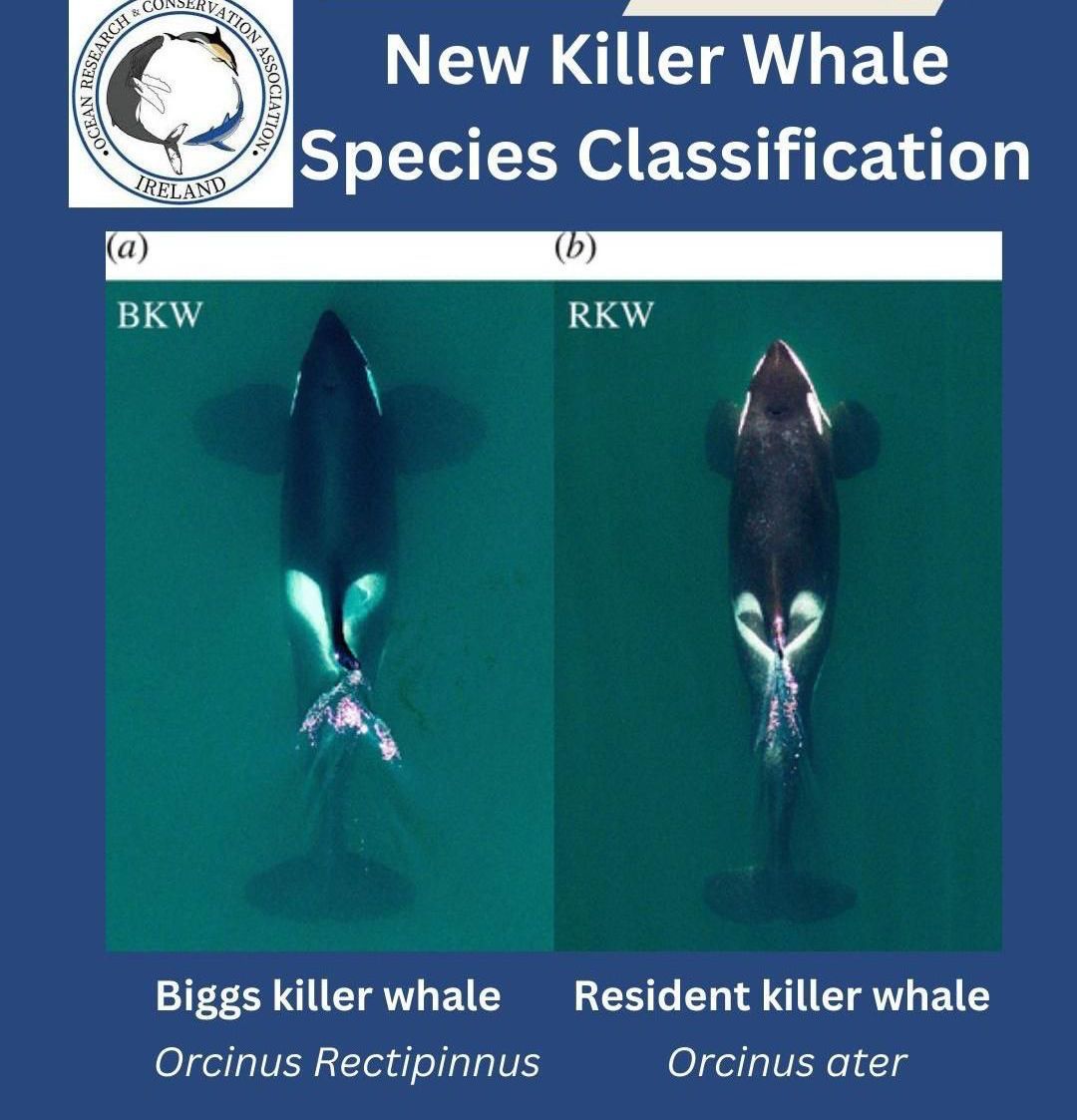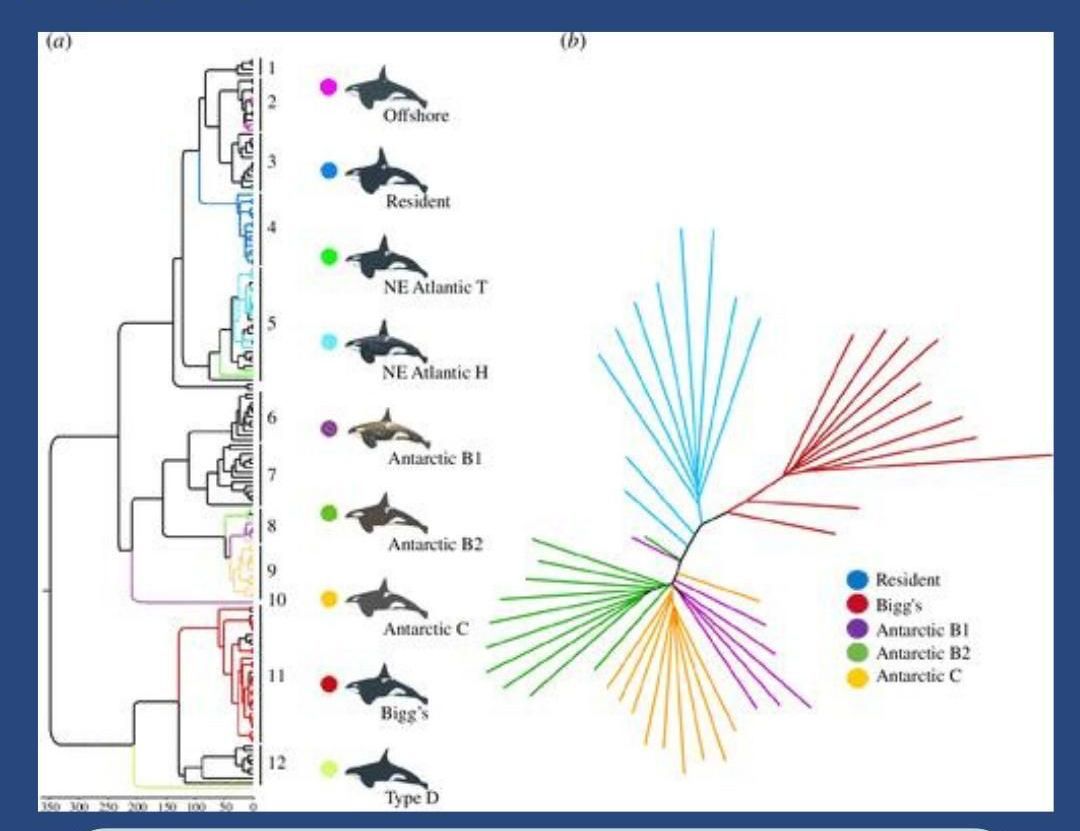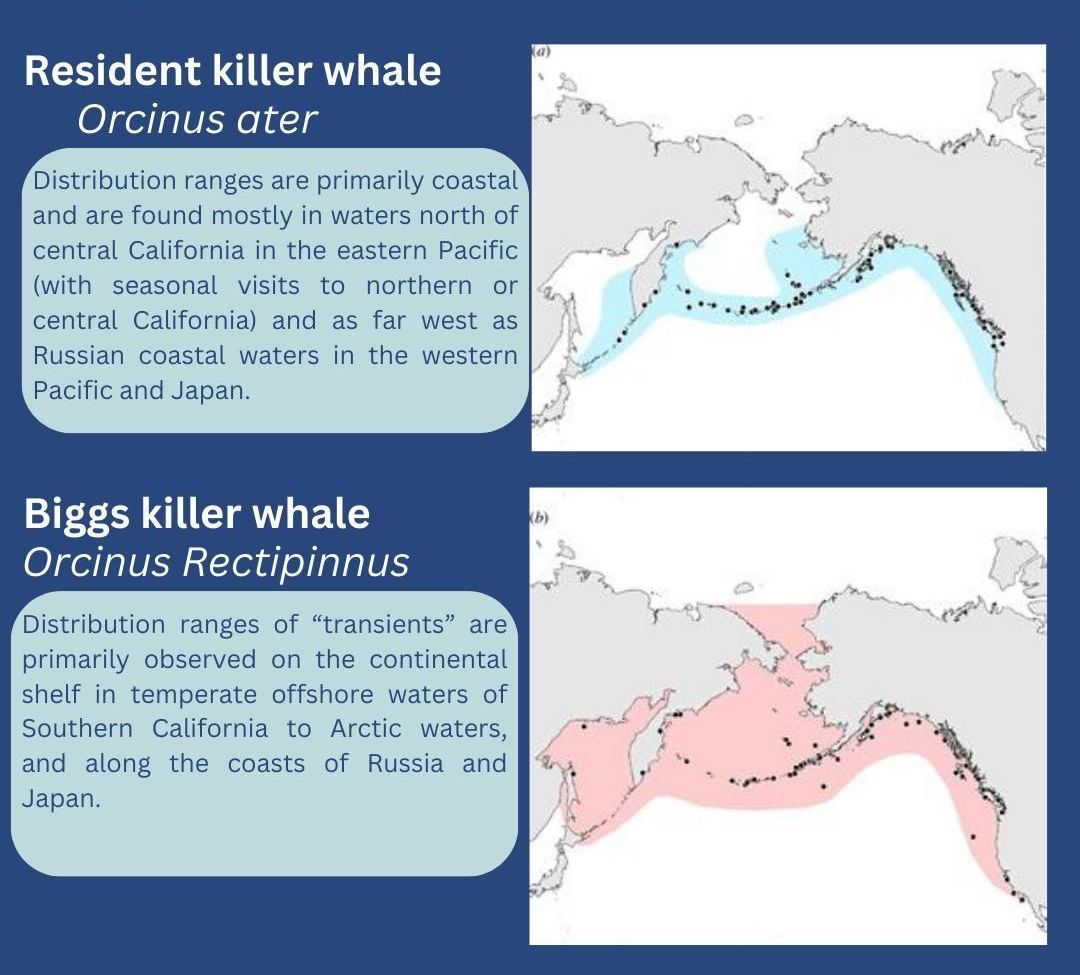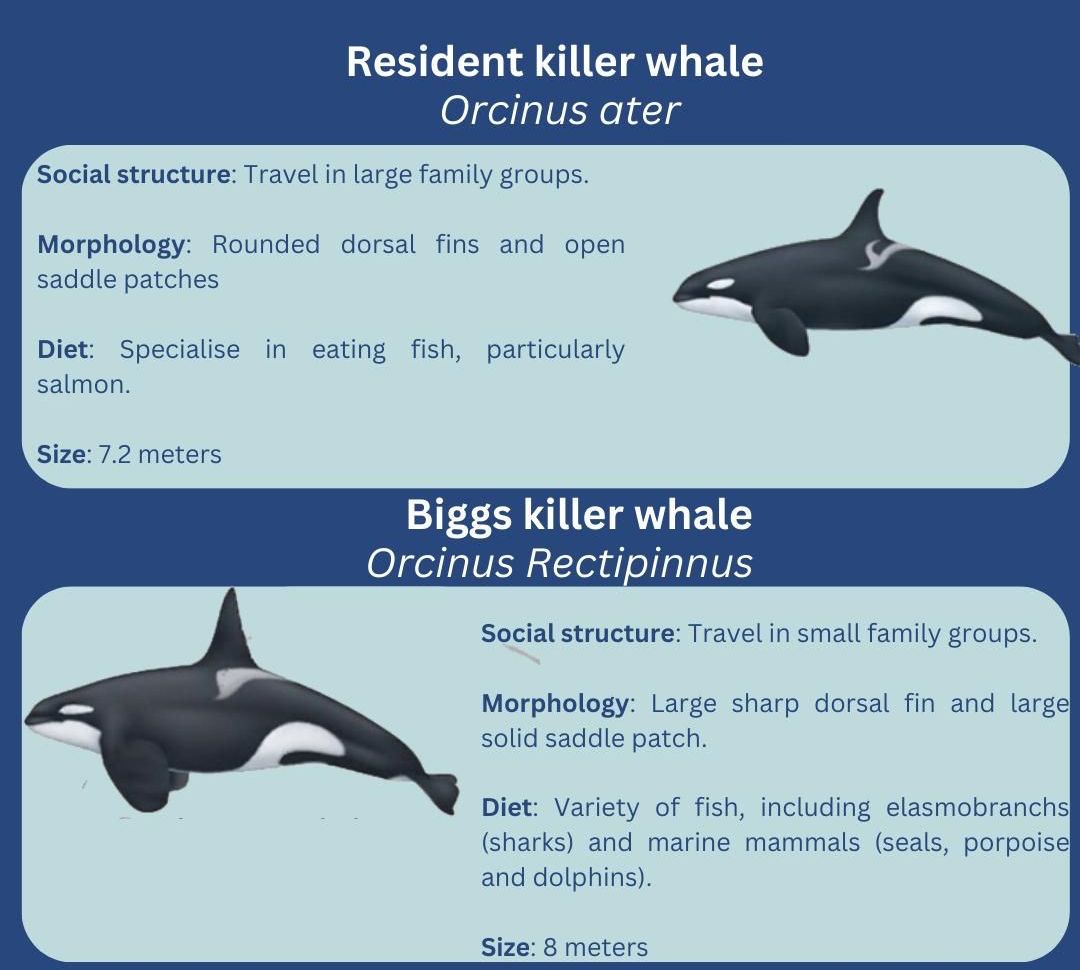New Research on Distinct Species of Killer Whales
New Research on Distinct Species of Killer Whales
Emer Keaveney/ ORCA SciComm | 29th March 2024
Killer whales, or orcas, have long captivated the human imagination with their intelligence, social structures, and striking appearance. In a recent study published in the journal Royal Society Open Science, researchers have shed light on a significant revelation regarding these cetaceans taxonomic classification. The study proposes the recognition of two distinct populations of killer whales - resident and Bigg's killer whales - as separate species. This distinction not only sets them apart from each other but also distinguishes them from the broader group of killer whales.

Introduction:
Although the orca is arguably one of the most recognized species of cetacean (porpoise, dolphin and whale), there has been much debate regarding the taxonomy of Orcinus orca, which to date has been recognised among the scientific community as a single species with diverse ecotypes. According to several cetacean experts (i.e. Morin et al. 2010; Moura et al., 2014), significant orca research has only spanned the last 30 years and has mainly been focused on orca behavior and ecology. Consequently, orca genetics and species taxonomy have been somewhat overlooked. Of the 20,000 cetacean research papers published in the last century, only 98 have been dedicated to orca genetics or taxonomy (Moura et al., 2014).
It is widely considered that the killer whale's western science taxonomic history began in 1758 when Carl Linnaeus first described it as a species (Delphinus orca). The first recognition of potential orca subspecies differentiation was in 1846 when a female orca skull was discovered in the Pelly River, Yukon (COSEWIC 2008). The skull was later identified as the only specimen of what is now known as the "northern resident" ecotype. Prior to its distinction as an ecotype, J.P. Vanstone concluded in his research of fish-eating killer whales that residents were a separate species from transient orcas. However, this conclusion was based on behavior observations only, and the resident or transient taxon was not officially recognized until the late 20th century (Bigg et al. 1990). Today, there are at least 10 different orca ecotypes that are distinguishable by both physical and behavioral characteristics. These ecotypes are likely isolated populations with minimal interbreeding, and as Hoelzel states, they may exist as "incipient species" considering their barriers to gene flow.
Significance of Species Differentiation:
Type of organism is the fundamental concept in biological expectation. Without belaboring the point, the overall similarity and ecological similarity or functional role reflected in genetic or phenetic similarity provide the basis for species recognition in simple and higher life forms (Van Valen, 1976). These authors contend that species are identifiable when they can document three forms of similarity: genealogical, morphological, and ecological. Genealogical identification is difficult as it depends upon the comparison of genetic material (which is often difficult to obtain from historical samples) but agreement upon the other two forms of similarity often allows confirmation of a particular hypothesis, thus simulating the hypothetico-deductive model of scientific inquiry. Decision on the similarity of two species morphologically and ecologically is usually made by intuitive comparison of the two in what Ernst Mayr refers to as "typological thinking" (Mayr, 1963), though in some cases statistical tests on measurements or environmental data may be carried out.
Species membership can be confirmed if the specimen has characteristics suggesting it belongs to one species, and not characteristics which are in the range of variation found in another species, a method known as the differential diagnosis. In the last sixty years, such studies in museum collections have been trying to determine the number of species of killer whale in a single area, without knowledge of the true number. With the advent of photography, dart biopsying and tissue sampling, and rapidly improving technology in the fields of genetics and statistics, it has become increasingly possible to document and process killer whale data for the purpose of hypothesis testing on species differentiation.
The differentiation between resident (Orcinus ater) and Bigg's killer whales (Orcinus rectipinnus) marks a crucial milestone in our understanding of these marine mammals. The research team used a combination of methods, including aerial imaging (known as photogrammetry), measurements and genetic analysis of museum specimens. While the groups of whales may share similarities in physical characteristics and ecological niches, genetic analyses have revealed significant enough differences to classify them as separate species. Previous studies analyzing genetic data also indicated that the two species likely diverged more than 300,000 years ago and come from opposite ends of the killer whale family tree. This means they are about as genetically distinct to other killer whale ecotypes around the globe. These later studies of genomic data have confirmed that they have evolved as genetically and culturally distinct groups, which occupy different niches in the same Northwest marine ecosystem.

This reclassification underscores the complexity within the world of killer whales and highlights the importance of recognizing unique populations for conservation efforts. Additionally, Michael Bigg noted in the 1970s that the two types did not mix with each other even when they occupied many of the same coastal waters, which may indicate different species.

Resident killer whales typically exhibit specialized diets focused on fish consumption, specializing on salmon, have tight-knit family pods and display strong fidelity to specific regions or habitats. On the other hand, Bigg's killer whales, also known as “transients” travel in smaller groups, and demonstrate a more varied diet that includes marine mammals such as seals and whales. Therefore, their social behaviors and hunting strategies differ significantly from those of resident killer whale populations. The new drone research has revealed that the difference in foraging strategies may be facilitated by Bigg’s killer whale’s larger body size, allowing them to hunt larger prey.

If the new re-classification is to be accepted among the scientific community is yet to be seen. However, by acknowledging resident and Bigg's killer whales as distinct species, researchers provide valuable insights into their evolutionary history and ecological roles within marine ecosystems. Furthermore, understanding these distinctions can enhance conservation strategies tailored to protect each population effectively.
This scientific breakthrough exemplifies how ongoing research continues to deepen our knowledge of iconic wildlife species like killer whales. As we strive to safeguard biodiversity in our oceans, recognizing unique populations such as resident and Bigg's killer whales paves the way for targeted conservation efforts aimed at preserving these remarkable and highly threatened marine mammals for generations to come.
References:
Bigg, M.A., Olesiuk, P.F., Ellis, G.M., Ford, J.K.B. and Balcomb, K.C., 1990. Social organization and genealogy of resident killer whales (Orcinus orca) in the coastal waters of British Columbia and Washington State. Report of the International Whaling Commission, 12, pp.383-405.
COSEWIC (Committee on the Status of Endangered Wildlife in Canada). 2008. COSEWIC annual report. COSEWIC, Gatineau.
Durban JW et al. . 2022 Integrating remote sensing methods during controlled exposure experiments to quantify group responses of dolphins to navy sonar. Mar. Pollut. Bull. 174 , 113194.
Morin, P.A., Archer, F.I., Foote, A.D., Vilstrup, J., Allen, E.E., Wade, P., Durban, J., Parsons, K., Pitman, R., Li, L. and Bouffard, P., 2010. Complete mitochondrial genome phylogeographic analysis of killer whales
(Orcinus orca)
indicates multiple species.
Genome research,
20(7), pp.908-916.
Morin, P.A., McCarthy, M.L., Fung, C.W., Durban, J.W., Parsons, K.M., Perrin, W.F., Taylor, B.L., Jefferson, T.A. and Archer, F.I., 2024. Revised taxonomy of eastern North Pacific killer whales (Orcinus orca): Bigg’s and resident ecotypes deserve species status.
Royal Society Open Science,
11(3), p.231368.
Moura, A. E., Kenny, J. G., Chaudhuri, R., Hughes, M. A., Welch, A. J., Reisinger, R. R., de Bruyn, P. J. N., Dahlheim, M. E., Hall, N., & Hoelzel, A. R. (2014). Population genomics of the killer whale indicates ecotype evolution in sympatry involving both selection and drift.
Molecular Ecology,
23(22), 5179-5192.
Mayr, E., 1963.
Animal species and evolution. Harvard University Press.
Van Valen, L., 1976. Ecological species, multispecies, and oaks.
Taxon, pp.233-239.
SHARE THIS ARTICLE













